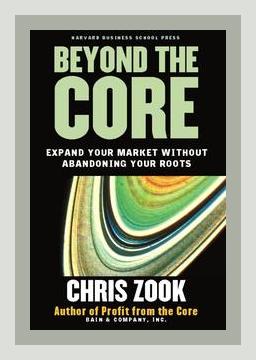Business StrategyCompetitive Strategy
Title: Beyond the Core: Expand Your Market Without Abandoning Your Roots
Author: Chris Zook
Publication Year: 2004
Category: Competitive Strategy
Introduction
Chris Zook’s book, Beyond the Core: Expand Your Market Without Abandoning Your Roots, is a seminal text in the realm of competitive strategy that equips businesses with a methodology for expanding their markets while staying true to their foundational strengths. The book argues that companies frequently falter when attempting to diversify, largely because they abandon the core competencies that initially brought them success. Zook provides an insightful roadmap for sustainable growth by leveraging existing capabilities.
Chapter 1: Understanding the Core
Main Points:
1. Definition of Core:
– The core is described as the amalgamation of assets, core competencies, and proprietary advantages that distinguish a company.
2. Core as a Source of Stability:
– A solid understanding of a company’s core provides a stable base for expansion strategies.
Concrete Examples:
– Dell Computers:
– Dell’s core was its direct-to-customer sales model and efficient supply chain. By leveraging this, they could expand into related product areas like printers and servers without overextending.
Actionable Step:
– Conduct a Core Analysis:
– Identify and document core assets, competencies, and distinct advantages. Use this analysis to evaluate potential market expansions.
Chapter 2: The Logic of Growth Beyond the Core
Main Points:
1. Adjacency Moves:
– Growth through adjacency involves moving into related markets or expanding offerings to leverage existing strengths.
2. Risks of Diversification:
– Overdiversification can dilute resources and shift focus away from core competencies.
Concrete Examples:
– Procter & Gamble (P&G):
– P&G expanded beyond soap and candles by entering related categories such as personal care and health care, leveraging their strong brand and distribution channels.
Actionable Step:
– Identify Adjacencies:
– Map out adjacent market opportunities that align with your core competencies. Evaluate their potential to complement or strengthen your core.
Chapter 3: Five Strategic Expansion Paths
Main Points:
1. Product/Service Expansion:
– Extend your product line or services that naturally align with your expertise.
2. Customer/Channel Expansion:
– Reach new customer segments or use new channels.
3. Geographic Expansion:
– Enter new geographic markets.
4. Forward/Backward Integration:
– Control more of the supply chain either by acquiring suppliers or distributors.
5. New Businesses from Core Competency:
– Build entirely new businesses based on unique competencies.
Concrete Examples:
– Nike:
– Initially a shoe company, Nike expanded into apparel and equipment by leveraging their strong brand and manufacturing expertise.
Actionable Step:
– Strategic Assessment:
– Perform a strategic assessment to determine which of the five paths of expansion aligns best with your current resources and market position.
Chapter 4: Identifying Untapped Opportunities
Main Points:
1. Market Research:
– In-depth market research to identify customer needs and gaps your business can fill.
2. Internal Resources:
– Assess internal resources to understand untapped potential within the organization.
Concrete Examples:
– Amazon:
– Originally an online bookstore, Amazon expanded into various product categories and cloud services by spotting gaps in the market and leveraging its logistics and technology strengths.
Actionable Step:
– Resource Inventory:
– Create an inventory of internal capabilities and resources. Regularly analyze market trends to identify opportunities that align with these.
Chapter 5: Executing the Expansion Strategy
Main Points:
1. Focused Investment:
– Allocate resources strategically to ensure that expansion efforts are adequately supported.
2. Pilot Programs:
– Implement pilot programs to test the waters before full-scale rollouts.
Concrete Examples:
– Starbucks:
– Starbucks took a methodical approach to expand internationally, initially opening stores in select areas to understand and adapt to local tastes before broader rollouts.
Actionable Step:
– Develop Pilot Projects:
– Design and execute pilot projects in new markets. Gather data and feedback to refine strategies before larger investments.
Chapter 6: Managing Growth and Complexity
Main Points:
1. Simplicity and Focus:
– Maintain simplicity in operations even as the company grows.
2. Organizational Structure:
– Adapt organizational structures to handle increased complexity without losing agility.
Concrete Examples:
– General Electric (GE):
– Under Jack Welch, GE maintained a focused simplicity by keeping strong business units and divesting low-performing ones, ensuring agility and focus within its vast operations.
Actionable Step:
– Streamline Processes:
– Regularly review and streamline processes to avoid complexity. Ensure that expansion efforts do not burden your organizational structure.
Chapter 7: Leading Expansion Initiatives
Main Points:
1. Strong Leadership:
– Effective leadership is crucial for guiding expansion and ensuring alignment with the core.
2. Building a Growth Culture:
– Foster a culture that embraces controlled risk-taking and innovation.
Concrete Examples:
– Apple:
– Steve Jobs’ leadership successfully expanded Apple’s product line with the iPhone and iPad while remaining aligned with Apple’s core of innovative design and user experience.
Actionable Step:
– Cultivate Leadership:
– Develop leadership training programs focusing on growth and innovation. Encourage leaders at all levels to identify and act on growth opportunities.
Conclusion
Chris Zook’s Beyond the Core provides a structured and insightful approach to expanding a business without losing sight of the foundational strengths that drive success. By identifying and leveraging core capabilities, businesses can explore adjacent markets, manage growth complexity, and maintain operational simplicity. The numerous examples of successful companies serve to illustrate the principles Zook outlines, offering a practical guide for businesses seeking to grow sustainably.
Overall Actionable Strategy:
– Integrate Learnings:
– Create a comprehensive growth strategy that incorporates core analysis, adjacency identification, targeted market research, pilot execution, process streamlining, and leadership development. Regularly revisit and adjust the strategy to remain responsive to market changes and internal growth dynamics.
Word Count: 1,503
